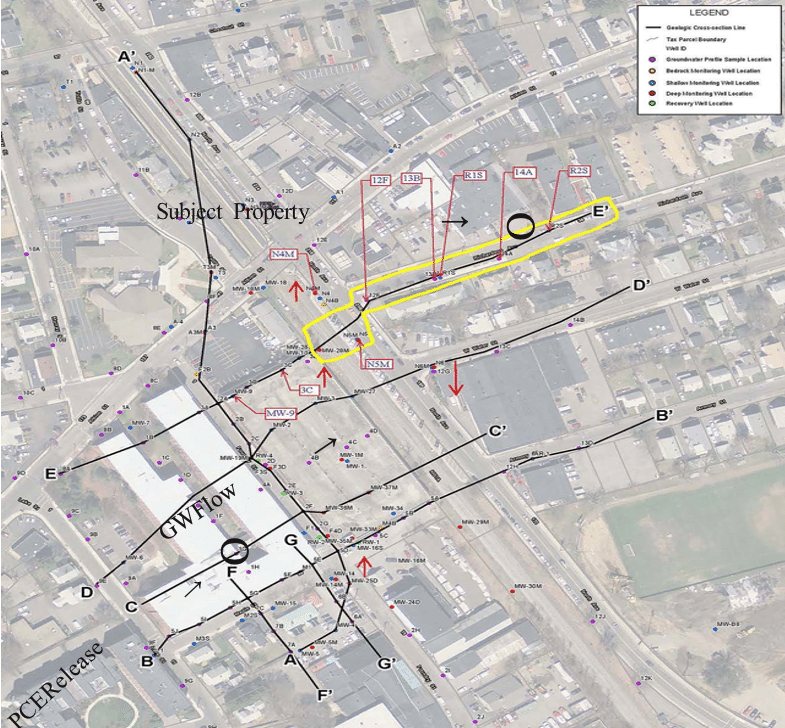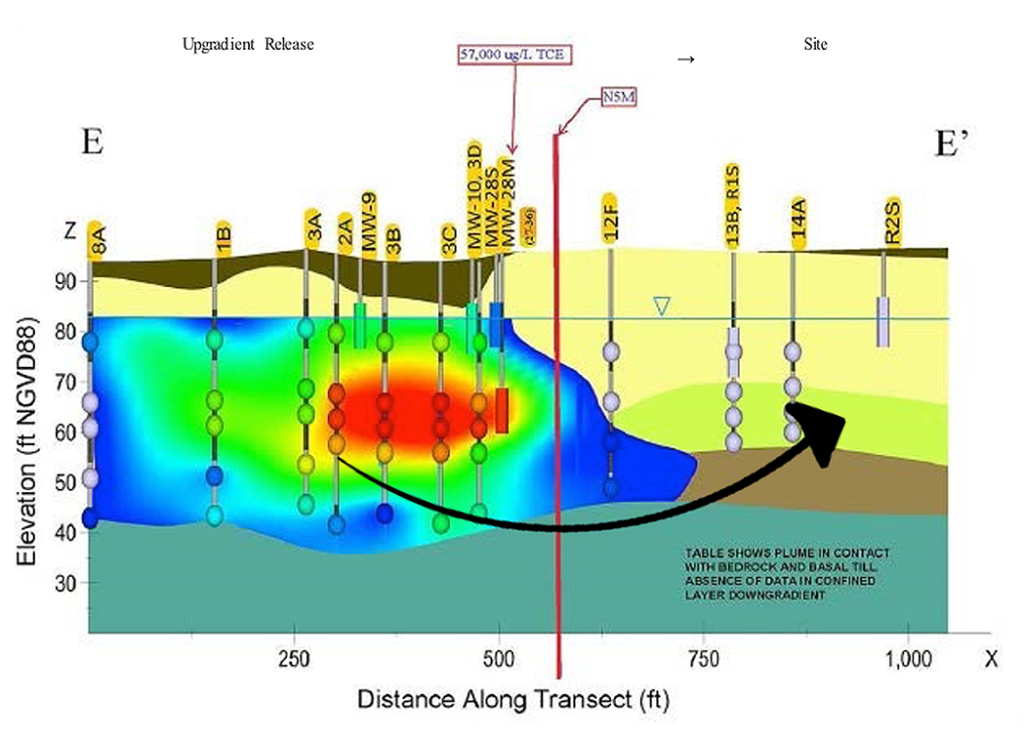Case Study
Using Passive Soil Gas Technique to Effectively Map PCE Plume
Pare recently completed a passive soil gas study (PSG) at an active automotive garage facility to identify the source and limits of an undocumented tetrachloroethylene (PCE) release on a client’s property.
For this situation, passive soil gas sampling was seen as a preferable alternative since PCE concentrations in the subsurface were expected to be below the detection threshold of conventional soil gas measuring tools. Furthermore, the precision allowed by passive soil gas measurements would be ideal for mapping relative concentrations as needed for delineation purposes. The test results provided detailed mapping of an unknown plume and allowed a determination of the source area faster than active soil gas sampling could have achieved.
PCE is an organic solvent that was widely used as used a parts cleaner and degreaser as well as a dry-cleaning agent. It is still widely used today. It is a suspected human carcinogen and has caused cancers in animal studies. Several dry cleaners and industrial facilities were located in this area in the past, any one of which could be a source or a contributing factor to PCE in the groundwater.
A Phase I Environmental Site Assessment was completed when the property of our case study was purchased in 2007. That study did not identify any historical use of PCE. Additionally, a Phase II Study consisting of six borings and three wells were drilled and tested. PCE was not detected in the soil, but a low level was detected in one of the wells, which was dismissed by the consultant at the time as being non-reportable.
In 2016, the Massachusetts Department of Environmental Protection (MassDEP) was investigating a large PCE release from a nearby industrial property, which led them to believe that a separate release of PCE may be occurring from our client’s property. The client produced the environmental study completed in 2007 to demonstrate proper compliance regarding potential environmental contaminants. Upon MassDEP review, the agency found an error in the report requiring notification and additional assessment by the property owner.
A MassDEP required Phase I Environmental Site Assessment was completed in 2018 by the property owner. A review of the facility’s historical records, site observations, interviews with the current service providers and previously completed environmental reports did not indicate any clear evidence of a release on site or of any known releases, previous source or sources, suspect storage areas or activities other than automotive services. Nevertheless, Pare evaluated several potential sources of PCE including off-site sources, floor drains, waste storage areas, and service bays. It quickly became apparent that a subsurface sampling plan involving the installation of several monitoring wells scattered throughout the property would be very expensive and would likely not yield the kind of information desired by the client, who wanted to determine if the PCE was migrating onto the site from off-site sources or if it originated on the site.
In Massachusetts, shallow groundwater (i.e. within 15 feet of the surface) that is contaminated with a compound that easily vaporizes must be considered a vapor hazard until shown otherwise. Groundwater at the site was known to be at approximately 15 feet below ground surface and just at the threshold of concern for vapor intrusion/migration into the building interior. There was concern that vapor concentrations measured by a conventional photoionization detector or via headspace samples would be too dilute and have insufficient accuracy to provide a meaningful delineation pattern. In other words, all the data may look the same or be below levels which could be quantified. So, in addition to evaluating the source of the release, it was also necessary to evaluate the potential for vapor intrusion hazards.
A photoionization detector and headspace samples are measured in the parts per million range, whereas the contaminant in the soil gas phase may be present in the parts per billion or less range. Because of this, Pare opted to initiate a passive soil gas sampling program which is capable of measuring contaminants in the parts per trillion range or as total nanograms.
Passive soil gas samplers utilize adsorbent media in a small vial with a permeable membrane. The vial is placed in the subsurface in an open borehole. By sampling over a period of several days, temporal variations in soil-gas concentrations are normalized and relative concentrations in space become more pronounced.
Passive soil gas methods have been demonstrated to be more sensitive, since they are able to capture more of the contaminant of interest over time than active samplers that induce a flow rate over a short period, which have the potential of vacuums or cavitation of subsurface vapor pathways.
Pare installed a total of 32 vapor points through two rounds of sampling. The resulting data was presented in units of mass per contaminant collected on the adsorbent media, expressed in total nanograms.
The comparison of data points shows a concentration gradient pattern that depicts a source area on site and a small amount of PCE migrating onto the site from the direction of the large industrial release. Although the first round of sampling only captured approximately half of the plume, it showed a separate release area in an unexpected area of the site. Furthermore, the sample results showed that the building was not likely the primary source of contamination of the PCE detected in the well.
With this information, Pare completed an additional round of sampling. The results were then plotted on a scaled survey plan using an environmental software package that interpolated results and presented the data in color format. The resulting image depicts the soil gas results as a function of color with the lower concentrations depicted as greens and blues and the higher concentrations as oranges and red. The dark orange shade shown on the figure represents the highest concentration of PCE with a expected attenuation pattern typical of a plume.
The passive soil gas technique was successfully utilized at the property and clearly delineated a heretofore, unknown plume of PCE originating on the client’s property that was not associated with any of the suspect source areas (floor drains, storage area or off-site sources) or the nearby plume. The delineation of the plume also allowed for effective placement of groundwater monitoring wells to assess risk and vapor migration areas of concern.
Based on the findings of the PSG study, Pare was able to delineate the plume and evaluate the source area with a minimal amount of borings and wells that were installed at precisely chosen locations. Based on conventional soil and groundwater sample results collected at the center and perimeter of the defined plume, Pare was able to demonstrate with a high degree of confidence that the contamination was emanating from a bedrock spring condition, and the PCE was likely related to the upgradient source, essentially absolving our client of remedial responsibilities.
Source: Flynn, M.P., 2020. Case Study Using Passive Soil Gas Technique to Effectively Map Plume, Presented at the 36th Annual International Conference on Soils, Sediments and Water, at the University of Massachusetts at Amherst.
Figure Descriptions
- Figure 1: Site and Surrounding Area; note proximity of large industrial site upgradient of subject property
- Figure 2: Plume configuration E – E’; note plume is in contact with bedrock condition at industrial release site and may be transporting PCE through confined aquifer. Upward migration (positive pressure in confined aquifer) is noted throughout the area (see Figure 1).
- Figure 3: Plume Configuration E2-E2’; note plume is in contact with bedrock condition at industrial release site and may be transporting PCE through confined aquifer. Upward migration (positive pressure in confined aquifer) is noted throughout the area (see Figure 1). Also note how plume appears to end in unconfined aquifer before reaching site.
- Figure 4: Passive Soil Gas results are indicative of a point source release; outside of the building in an area of no measured surface or subsurface soil contamination (i.e. no evidence of a surficial or vadose zone release).
Stay Connected
Be the first to know! Sign up and receive breaking news, valuable technical information, and industry updates from Beacon Environmental.



